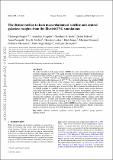The distinct stellar-to-halo mass relations of satellite and central galaxies: insights from the IllustrisTNG simulations
Author(s)
Engler, Christoph; Pillepich, Annalisa; Joshi, Gandhali D; Nelson, Dylan; Pasquali, Anna; Grebel, Eva K; Lisker, Thorsten; Zinger, Elad; Donnari, Martina; Marinacci, Federico; Vogelsberger, Mark; Hernquist, Lars; ... Show more Show less
DownloadSubmitted version (1014.Kb)
Open Access Policy
Open Access Policy
Creative Commons Attribution-Noncommercial-Share Alike
Terms of use
Metadata
Show full item recordAbstract
© 2021 Oxford University Press. All rights reserved. We study the stellar-to-halo mass relation (SHMR) for central and satellite galaxies with total dynamical masses above 1010.5 M⊙ using the suite of cosmological magnetohydrodynamical simulations IllustrisTNG. In particular, we quantify environmental effects on satellite populations from TNG50, TNG100, and TNG300 located within the virial radius of group- and clusterlike hosts with total masses of 1012-15.2 M⊙. At fixed stellar mass, the satellite SHMR exhibits a distinct shift towards lower dynamical mass compared to the SHMR of centrals. Conversely, at fixed dynamical mass, satellite galaxies appear to have larger stellar-to-total mass fractions than centrals by up to a factor of a few. The systematic deviation from the central SHMR is larger for satellites in more massive hosts, at smaller cluster-centric distances, with earlier infall times, and that inhabits higher local density environments; moreover, it is in place already at early times (z 2). Systematic environmental effects might contribute to the perceived galaxy-to-galaxy variation in the measured SHMR when galaxies cannot be separated into satellites and centrals. The SHMR of satellites exhibits a larger scatter than centrals (by up to ∼0.8 dex), over the whole range of dynamical mass. The shift of the satellite SHMR results mostly from tidal stripping of their dark matter, which affects satellites in an outside-in fashion: The departure of the satellite SHMR from the centrals' relation diminishes for measurements of dynamical mass in progressively smaller apertures. Finally, we provide a family of fitting functions for the SHMR predicted by IllustrisTNG.
Date issued
2020Department
MIT Kavli Institute for Astrophysics and Space Research; Massachusetts Institute of Technology. Department of PhysicsJournal
Monthly Notices of the Royal Astronomical Society
Publisher
Oxford University Press (OUP)
Citation
Engler, Christoph, Pillepich, Annalisa, Joshi, Gandhali D, Nelson, Dylan, Pasquali, Anna et al. 2020. "The distinct stellar-to-halo mass relations of satellite and central galaxies: insights from the IllustrisTNG simulations." Monthly Notices of the Royal Astronomical Society, 500 (3).
Version: Original manuscript